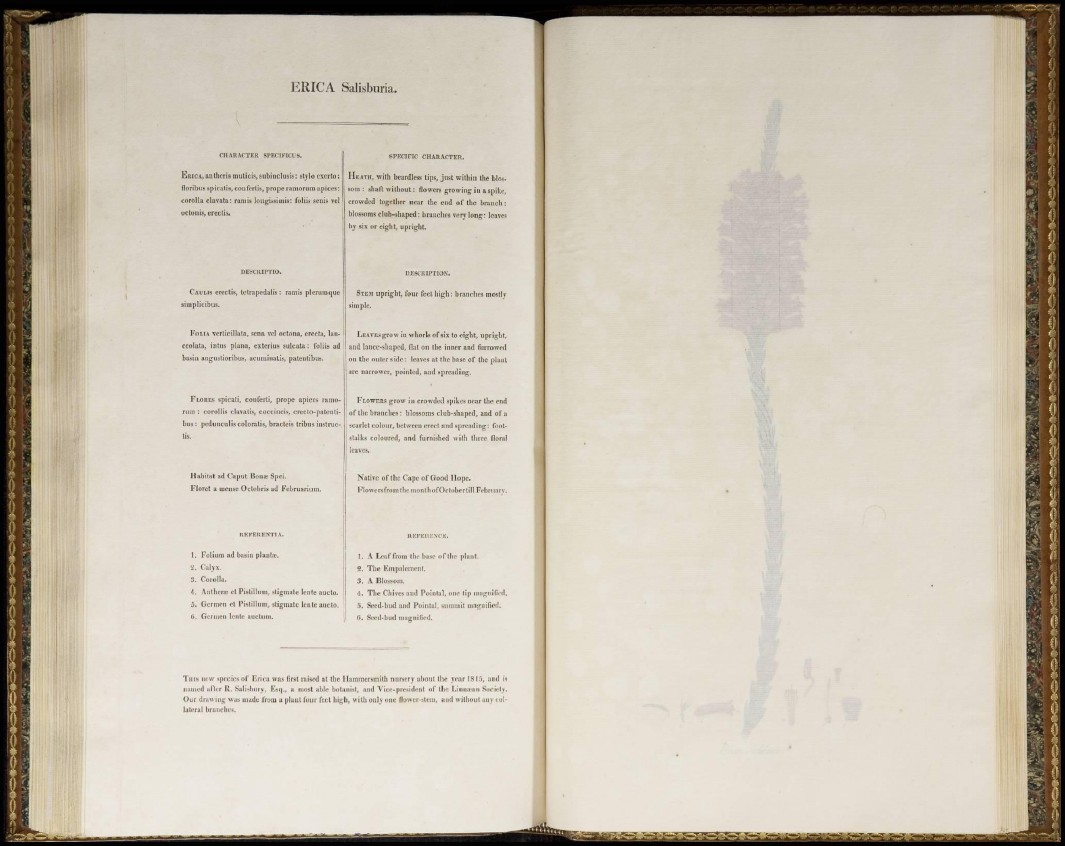
ERICA Salisburia.
CHARACTER SPECIFICUS.
ERICA, anthcris muticis, subinclusis: stylo exerto:
floribus s pic at is, coufcrtis, prope ramoruui apices :
corolla clavata: rauns longissiinis: foliis seuis vel
octouis, erectis.
DKscnipno.
CAULIS erectis, tctrapedalis : ramis pleruroque
Bimplicibus.
FOLIA verlicillata, scna vel octona, erecta, lanceolata,
infus plana, cxterins sulcata ; foliis ad
basin angustioribus, acuniiualis, patentibus.
FLORES spicati, couferti, prope apices ramorum
: corollis clavalis, coccineis, erecto-patentibus
: peduueulis coloratis, bractcis tribus instructis.
Habitat ad Caput Bona; Spei.
Floret a inense Oclobris ad Februari urn.
REFERENT1A.
1. Folium ad basin planta.'.
2. Calyx.
3. Corolla.
A. Anthcra" ct Pistillum, stigmate lente aucto.
5. Gcrnien et Pistiilum, stigmate lente aucto.
6. Germon lente auctum.
SPECIFIC CHARACTER.
HEATH, with beardless tips, just within the blossom
: shaft without: flowers growing in a spike,
crowded together near the end of the branch :
blossoms club-shaped: branches very long: leaves
by six or eight, upright.
DESCRIPTION.
STEM upright, four feet high: brandies mostly
simple.
LEAVES grow in whorls of six to eight, upright,
and lance-shaped, flat on the inner and furrowed
on the outer side: leaves at the base of the plant
are narrower, pointed, and spreading.
FLOWERS grow in crowded spikes near the end
of the branches: blossoms club-shaped, and of a
scarlet colour, between erect and spreading: footstalks
coloured, and furnished with three floral
Native of the Cape of Good Hope.
Flowers from the month of Octobcrtill February.
REFERENCE.
1. A Leaf from the base ofthe plan!.
2. The Empalement.
3. A Blossom.
4. The Chives and Pointal, one lip magnified.
5. Seed-bud and Pointal, summit magnified,
6. Seed-bud magnified.
THIS new species of Erica was first raised at the Hammersmith nursery about the year 1815, and is
named after 11. Salisbury, Esq., a most able botanist, and Vice-president of the Liumr.an Society.
Our drawing was nude from a plant four feet high, with only one flower-stem, and without any collateral
branches.